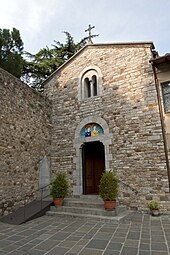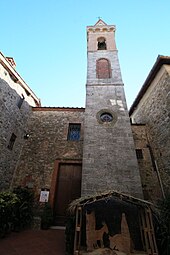San Gusmè
| San Gusmè | |||
|---|---|---|---|

|
|||
| Panorama of San Gusmè | |||
| Country | Italy | ||
| region | Tuscany | ||
| province | Siena (SI) | ||
| local community | Castelnuovo Berardenga | ||
| Coordinates | 43 ° 23 ' N , 11 ° 30' E | ||
| height | 465 m slm | ||
| Residents | 239 (2017) | ||
| patron | Santi Cosma e Damiano | ||
| Telephone code | 0577 | CAP | 53019 |
San Gusmè is a district ( fraction , Italian frazione ) of Castelnuovo Berardenga in the province of Siena , Tuscany region in Italy .
geography
The place, formerly also called San Gusmè in Campi , San Gusmè nel Chianti or Castello San Cosmae , is 5 km north of the main town Castelnuovo Berardenga and 16 km northeast of the provincial capital Siena in the eastern part of Chianti Senese on the Monte Luco mountain . The place is on the river Ombrone at 465 m slm and in 2001 had about 250 inhabitants. In 2017 there were 239 inhabitants.
history
The place is named after the old church Santi Cosma e Damiano , from which Sancti Cosme and later San Gusmè became. The place was first mentioned in writing in February 867, when Winigi di Raginieri (Ranieri) and his wife Richilda founded the Monastero di San Salvatore della Berardenga . In 1167, Cristiano Vescovo di Magonza, vicar of Frederick I , took over the place as a fief . Twenty years later, the place or the castle with Borgo (lower town) came to the Ricasoli family , which Henry VI. has been confirmed. On September 11, 1478, San Gusmè was taken by Alfonso II . Much greater damage to the place occurred in the conflict between Siena and Florence, when the place was first captured by troops from Florence on February 25, 1554 , and on May 13 of the same year when the place was burned down by the same military units.
The place was independent until June 2, 1777, then it came to Castelnuovo Berardenga as a district through the regional reform Riforma Leopoldina of Leopold II . The patron saints of the place are St. Cosmas and Damian .
A simple memorial in the cemetery of the village of San Gusmè reminds of this: On July 4th, 1944, nine villagers, mostly women and small children, were shot by German soldiers from Hermann Göring's division. In 2014 the German-Italian theater project “Albicocche rosse - Bloody Apricots” by Ulrich Waller together with Matteo Marsan and Dania Hohmann about the war crimes of the German soldiers on site was performed.
Attractions
- Pieve dei Santi Cosma e Damiano , Pieve in the town center, which has been known since 867 and was initially under the Pieve of San Felice (San Felice in Pincis). The current facade dates from the 20th century.
- Chiesa della Santissima Annunziata , also Chiesa della Compagnia della Santissima Annunziata , church in the center from the 14th century.
- Luca Cava , ironic stone statue by Giovanni Bonechi from 1888, which was destroyed in the 1930s and reinstalled as a ceramic figure by Marcello Neri on the initiative of Silvio Gigli in the 1970s. The design comes from Emilio Giannelli. The inscription reads re, imperatore, papa, filosofo, poeta, contadino e operaio: l'uomo nelle sue quotidiane funzioni. Non ridete, pensate a voi stessi. (King, ruler, pope, philosopher, poet, farmer and worker: man doing his daily chores. Don't laugh, think [better] about yourself).
- Parts of the old city walls, which were built from 1370 with two city gates. The two city gates from the 14th century are the Porticciola , also called Porta Senese (still contains the coat of arms ( Balzana ) of the Senese Republic) and the south-western gate. The third, Porta Nuova , dates from 1939.
- Villa Arceno , villa of the Piccolomini Clementini family, which is about 1 km south of the village and dates from the 17th century. Was redesigned in 1833 by the Senese architect Agostino Fantastici (* 1782 in Siena, † July 24, 1845 ibid.) And expanded to include the garden and the chapel.
- San Lorenzo , church in the Località Campi (also Campi nel Chianti or Campi della Berardenga ). Church from the late 18th / early 19th century. Contains a canvas painting (Martirio di San Lorenzo) from the 18th century.
- Sorgenti dell'Ombrone , source of the river between Campi (646 m) and San Gusmè about 500 meters north of the village.
Sons and daughters of the place
- Pietro Sorri , painter, * 1556 in San Gusmè
Trivia
- The German actress, set designer and director Elke Lang was buried on January 24, 1998 in the San Gusmè cemetery.
photos
- Monuments of San Gusmè
literature
- Enrico Bosi, Giovanna Magi: I Castelli del Chianti. Bonechi Editrice, Florence 1979, ISBN 88-7009-000-0 , p. 153.
- Emanuele Repetti: GUSMÈ (S.) NEL CHIANTI, o S. GUSMÈ IN CAMPI (Castello S. Cosmae) in Val d'Ombrone senese. In: Dizionario Geografico Fisico Storico della Toscana (1833–1846) , online edition of the University of Siena (pdf, Italian)
- Touring Club Italiano : Toscana. Milan 2003, ISBN 978-88-365-2767-0 , p. 619.
Web links
- Website of the Pro Loco in San Gusmè
- EcoMuseo Chianti to San Gusmè
- San Gusmè at Italia in dettaglio
Individual evidence
- ↑ a b c Emanuele Repetti: GUSMÈ (S.) NEL CHIANTI, o S. GUSMÈ IN CAMPI (Castello S. Cosmae) in Val d'Ombrone senese. In: Dizionario Geografico Fisico Storico della Toscana (1833–1846)
- ↑ Official website of ISTAT ( Istituto Nazionale di Statistica ) on 2001 population figures in the province of Siena, accessed on May 18, 2012 (Italian)
- ↑ Italia in dettaglio to San Gusmè, accessed on 7 January 2018 (Italian)
- ↑ a b c EcoMuseo Chianti to San Gusmè
- ↑ Juliane Voigt: Meeting the horror together . Culture of remembrance: a German-Italian theater project.
- ↑ (sangusme.it/public/pages/territorio.asp) Website of the Pro Loco San Gusmè for the Chiesa della Santissima Annunziata, accessed on May 20, 2012 (Italian), no longer available
- ↑ (sangusme.it/public/pages/lucacava.asp) Website of the Pro Loco San Gusmè on Il Luca Cava , accessed on May 18, 2012 (Italian), no longer available
- ^ Rolando Cherubini: La mia terra di Siena: San Gusmè. Website, accessed January 10, 2017 (Italian)
- ^ Emilia Daniele, Paolo Bertoncini Sabatini: L'arte dell'abitare in Toscana. Forme e modelli della residenza fra città e campagna , Edizioni Polistampa, Florence 2011, ISBN 978-88-596-0839-4 , p. 255
- ^ Agostino Fantastici in the Dizionario Biografico degli Italiani , accessed on May 20, 2012 (Italian)
- ^ Enrico Bosi, Giovanna Magi: I Castelli del Chianti.
- ^ Castelnuovo Berardenga. Storia, Arte, Natura, Tradizioni. Aska, Florence 2014, ISBN 978-88-7542-098-7
- ↑ toscananatura.it: Le Sorgenti dell'Ombrone , accessed on January 10, 2017 (Italian)








